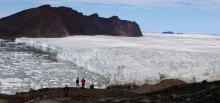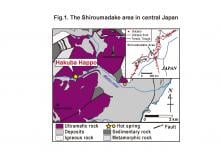Earth and Planetary Science Letters
News
27 Jan 2023
A “back-projection” technique reveals new details of the volcanic eruption in Tonga that literally shook the world.
31 Jan 2022
Dinosaurs came to flourish during the Jurassic period after a volcanic eruption roughly 201 millions years ago wiped out many marine and land animals, leaving them able to evolve and grow. Now, further details about this eruption and the mass extinction have been revealed. A group of researchers demonstrated how low temperature magma slowly heated sedimentary rocks, causing high sulfur dioxide and low carbon dioxide emissions, a process which cooled the earth.
22 Apr 2021
A research team, led by researchers from Tohoku University, has defined the events that punctuated the crustal history Northeast Japan. Their study has revealed the main ages of the events that shaped the geological roots of Japan.
12 Nov 2020
A team of researchers has discovered more about the grain-scale fluid connectivity beneath the earth's surface, shedding new light on fluid circulation and seismic velocity anomalies in subduction zones.
27 Sep 2020
Researchers have shaken up a once accepted timeline for cataclysmic events in the early solar system. Geological and geochemical records indicate that the Earth-Moon system experienced a period of frequent and cataclysmic impacts from asteroids and other bodies. It was thought that this period had a relatively sudden onset, but the researchers have found evidence that this bombardment period may have started much earlier, and decreased in intensity over time.
30 Jul 2020
In a recently published paper in Earth and Planetary Science Letters, researchers from the Geodynamics Research Center, Ehime University and the University of Lille combine numerical modeling of dislocation glide and results from diffusion experiments to revisit the rheology of wadsleyite, ringwoodite and majorite garnet under geological strain rates across the transition zone of the Earth’s mantle based on theoretical plasticity modeling.
01 Jul 2019
It is believed that terrestrial planets were made from chondrites. However, geochemical observations have shown that the abundance pattern of volatile elements is inconsistent with chondrites. New high-pressure experiments suggest that F and Cl fractionation during magma ocean crystallization could explain the non-chondritic Earth's F/Cl ratio.
08 May 2019
Scientists have employed a new method utilizing tsunami signals to calculate the calving magnitude of an ocean-terminating glacier in northwestern Greenland, uncovering correlations between calving flux and environmental factors such as air temperature, ice speed, and ocean tides.
11 Apr 2019
Evidence of historic marine life present in Alaskan permafrost is helping scientists reconstruct ancient changes in the ice cover over the Arctic Ocean.
18 Aug 2015
A new study shown that meteorite impacts on ancient oceans may have created nucleobases and amino acids.
22 Jan 2014
(Tokyo, 22 Jan 2014) Researchers at Tokyo Institute of Technology reveal mechanisms for the formation of methane, which may have been a crucial stage in the origin of life on Earth.
Events
Sorry, no events coming up for this topic.
Researchers
Sorry, no researchers coming up for this topic.
Giants in history
Sorry, no researchers coming up for this topic.













